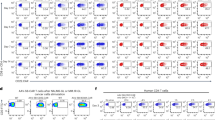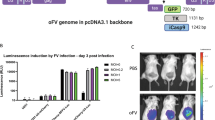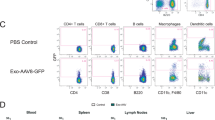Abstract
The goal of this project was to develop a novel gene transfer system based on macrophages (Mφ) as shuttles of recombinant retroviral vectors carrying therapeutic or marker genes. The murine Mφ cell line WGL5 was used as a source of Mφ for this study. We generated retrovirus-producing Mφ by transducing the WGL5 cells with a replication-defective retroviral vector carrying the enhanced green fluorescent protein (EGFP) reporter gene and the Moloney murine leukemia virus (MoMLV) as helper virus. We demonstrated stable integration of the recombinant retrovirus in the Mφ genome, efficient recombinant retrovirus production, and EGFP gene delivery to different cell lines in vitro. To evaluate Mφ-mediated EGFP gene transfer in vivo, allogeneic mice were injected s.c. with the retrovirus-producing WGL5 Mφ, that gave rise to solid tumor masses at the injection site, highly infiltrated with host leukocytes. We observed EGFP fluorescence in tumor-infiltrating CD4+ and CD8+ host T lymphocytes, providing direct evidence of the ability of engineered Mφ to mediate EGFP gene delivery to host cells in vivo. Moreover, we showed that retrovirus-producing Mφ could home to different organs in vivo following i.v. injection into mice. These data demonstrate that Mφ can be engineered as cellular vehicles for recombinant retroviruses carrying heterologous genes and suggest potential applications of this novel vector system for gene therapy.
This is a preview of subscription content, access via your institution
Access options
Subscribe to this journal
Receive 12 print issues and online access
$259.00 per year
only $21.58 per issue
Buy this article
- Purchase on Springer Link
- Instant access to full article PDF
Prices may be subject to local taxes which are calculated during checkout







Similar content being viewed by others
References
Verma IM, Somia N . Gene therapy-promises, problems and prospects Nature 1997 389: 239–242
Uckert W, Walther W . Retrovirus-mediated gene transfer in cancer therapy Pharmac Ther 1994 63: 323–347
Robbins PD et al. Retroviral vectors for use in human gene therapy for cancer, Gaucher disease, and arthritis Ann NY Acad Sci 1994 716: 72–89
Bordignon C et al. Gene therapy in peripheral blood lymphocytes and bone marrow for ADA-immunodeficient patients Science 1995 270: 470–475
Cavazzana-Calvo M et al. Gene therapy of human severed combined immunodeficiency (SCID)-XI disease Science 2000 288: 669–672
Bunnell BA et al. High-efficiency retroviral-mediated gene transfer into human and nonhuman primate peripheral blood lymphocytes Proc Natl Acad Sci USA 1995 92: 7739–7743
Roth JA, Cristiano RJ . Gene therapy for cancer: what have we done and where are we going? J Natl Cancer Inst 1997 89: 21–39
Culver KW et al. In vivo gene transfer with retroviral vector producer cells for treatment of experimental brain tumors Science 1992 256: 1550–1552
Ram Z et al. Therapy of malignant brain tumors by intratumoral implantation of retroviral vector-producing cells Nature Med 1997 3: 1354–1361
Tamura M et al. Transduction of glioma cells using a high-titer retroviral vector system and their subsequent migration in brain tumors Gene Therapy 1998 5: 1698–1704
Blasi E, Mathieson BJ, Varesio L . Selective immortalization of murine macrophages from fresh bone marrow by a raf/myc recombinant murine retrovirus Nature 1985 318: 667–670
Blasi E et al. A murine macrophage cell line, immortalized by v-raf and v-myc oncogene exhibited normal macrophage differentiated functions Eur J Immunol 1987 17: 1491–1498
Gandino L, Varesio L . Immortalization of macrophages from mouse bone marrow and fetal liver Exp Cell Res 1990 188: 192–198
Whitworth PW et al. Macrophages and cancer Cancer Met Rev 1990 8: 319–351
Gendelman HE, Morahan PS . Macrophages in viral infections. In: Lewis CE, McGee JO (eds) The Macrophage IRL PRESS: Oxford 1994 pp 157–213
Varesio L et al. Role of cytokines in the activation of monocytes. In: Aggarwal BB, Puri RK (eds) Human Cytokines: Their Role in Disease and Therapy Blackwell Scientific Publication: Cambridge 1995 pp 55–70
Bonta IL, Ben-Efraim S . Involvement of inflammatory mediators in macrophage antitumor activity J Leuk Biol 1993 54: 613–625
Mantovani A et al. The origin and function of tumor-associated macrophages Immunol Today 1992 13: 265–270
Unanue ER, Allen PM . The basis for the immunoregulatory role of macrophages and other accessory cells Science 1987 236: 551–557
Lei H et al. Induction of potent antitumor response by vaccination with tumor lysate-pulsed macrophages engineered to secrete macrophages colony-stimulating factor and interferon-γ Gene Therapy 2000 7: 707–713
Hennemann B et al. Phase I trial of adoptive immunotherapy of cancer patients using monocytes-derived macrophages activated with interferon-γ and LPS Cancer Immunol Immunother 1997 456: 250–256
Andreesen R, Hennemann B, Krause W . Adoptive immunotherapy of cancer using monocyte-derived macrophages: rationale, current status, and perspective J Leuk Biol 1998 64: 419–425
Kaplan JM et al. Induction of antitumor immunity with dendritic cells transduced with adenovirus vector-encoding endogenous tumor-associated antigens J Immunol 1999 163: 699–707
Nishihara K et al. Increased in vitro and in vivo tumoricidal activity of a macrophage cell line genetically engineered to express INFγ, IL4, IL6, or TNFα Cancer Gene Ther 1995 2: 113–124
Melero I et al. Intratumoral injection of bone-marrow derived dendritic cells engineered to produce interleukin-12 induces complete regression of established murine transplantable colon adenocarcinomas Gene Therapy 1999 6: 1779–1784
Henderson RA et al. Human dendritic cells genetically engineered to express high levels of the human epithelial tumor antigen mucin (MUC-1) Cancer Res 1996 56: 3763–3770
Cremer I, Vieillard V, Maeyer ED . Retrovirally mediated IFN-β transduction of macrophages induces resistance to HIV, correlated with up-regulation of RANTES production and down-regulation of C-C chemokine receptor-5 expression J Immunol 2000 164: 1582–1587
Levy JP, Muldoon RR, Zolotukhin S et al. Retroviral transfer and expression of a humanized, red-shifted green fluorescent protein gene into human tumor cells Nat Biotechnol 1996 14: 610–614
Morgenstern JP, Land H . Advanced mammalian gene transfer: high titre retroviral vectors with multiple drug selection markers and a complementary helper-free packaging cell line Nucleic Acids Res 1990 18: 3587–3596
Cepko C, Pear W . Introduction of DNA into mammalian cells. In: Ausubel FM et al (eds) Current Protocols in Molecular Biology John Wiley & Sons: New York, USA 1997 9.0.1–9.13.7
Hanazono Y et al. Green fluorescent protein retroviral vectors: low titer and high recombination frequency suggest a selective disvantage Hum Gene Ther 1997 8: 1313–1319
Challita PM, Kohn DB . Lack of expression from a retroviral vector after transduction of murine hematopoietic cells is associated with methylation Proc Natl Acad Sci USA 1994 91: 2567–2571
Palmer TD et al. Genetically modified skin fibroblast persist long after transplantation but gradually inactivate introduced genes Proc Natl Acad Sci USA 1991 88: 1330–1334
Pear WS, Scott ML, Nolan GP . Generation of high titre, helper-free retroviruses by transient transfection. In: Robbins PD (ed) Methods in Molecular Medicine: Gene Therapy Protocols Humana Press: Totowa 1996 pp 41–57
Miller AD . Cell-surface receptors for retroviruses and implications for gene transfer Proc Natl Acad Sci USA 1996 93: 11407–11413
Miller DG, Adam MA, Miller AD . Gene transfer by retrovirus vector occurs only in cells that are actively replicating at the time of infection Mol Cell Biol 1990 10: 4239–4242
Bosco MC et al. Selective transformation of host lymphocytes in vivo by retrovirus-producing macrophages J Immunol 1993 150: 278–289
Diamond AS, Gill RG . An essential contribution by IFN-γ to CD8+ T cell-mediated rejection of pancreatic islet allografts J Immunol 2000 165: 247–255
Ram Z et al. In situ retroviral-mediated gene transfer for the treatment of brain tumors in rats Cancer Res 1993 53: 83–88
Takamiya Y et al. An experimental model of retrovirus gene therapy for malignant brain tumors J Neurosurg 1993 79: 104–110
Ram Z et al. Intrathecal gene therapy for malignant leptomeningeal neoplasia Cancer Res 1994 54: 2141–2145
Kaneko Y, Tsukamoto A . Gene therapy of hepatoma: bystander effects and non-apoptotic cell death induced by thymidine kinase and ganciclovir Cancer Lett 1995 96: 105–110
Mavria G, Jäger U, Porter CD . Generation of a high retroviral vector for endothelial cell-specific gene expression in vivo Gene Therapy 2000 7: 368–376
Fassati A et al. Transplantation of retroviral producer cells for in vivo gene transfer into mouse skeletal muscle Hum Gene Ther 1996 7: 595–602
Wiltrout RH et al. Distribution of peritoneal macrophage populations after intravenous injection in mice J Reticuloendotel Soc 1983 34: 253–269
Morse MA et al. Migration of human dendritic cells after injection in patients with metastatic malignancies Cancer Res 1999 59: 56–58
Kennedy DW, Abkowitz JJ . Mature monocytic cells enter tissues and engraft Proc Natl Acad Sci USA 1999 95: 14944–14949
Parrish EP et al. Targeting widespread sites of damage in dystrophic muscle:engrafted macrophages as potential shuttles Gene Therapy 1996 3: 13–20
Melillo G et al. A hypoxia-responsive element mediates a novel pathway of activation of the inducible nitric oxide synthase promoter J Immunol 1995 182: 1683–1693
Acknowledgements
We thank Dr H Land (Imperial Cancer Research Fund, London, UK), Dr J Pierce (NIH, Bethesda, MD, USA) and Dr GP Nolan (Stanford University, Stanford, CA, USA) for kindly providing the pBabe-Puro construct, the MoMLV-producer SNU19 cells and the ΦNix packaging cell line, respectively. We also thank M Puppo (G Gaslini Institute, Genova, Italy) for her excellent technical support, and Dr M Lapide (IST, Genova, Italy) for in vivo experiments. This work was supported in part by grants from the Italian Telethon Foundation (project A75), the Associazione Italiana per la Ricerca sul Cancro (AIRC), the Centro Nazionale Ricerche (CNR) and Associazione Italiana per la Lotta al Neuroblastoma. Dr S Pastorino is supported by a fellowship from the Fondazione Italiana per la Ricerca sul Cancro (FIRC).
Author information
Authors and Affiliations
Rights and permissions
About this article
Cite this article
Pastorino, S., Massazza, S., Cilli, M. et al. Generation of high-titer retroviral vector-producing macrophages as vehicles for in vivo gene transfer. Gene Ther 8, 431–441 (2001). https://doi.org/10.1038/sj.gt.3301405
Received:
Accepted:
Published:
Issue Date:
DOI: https://doi.org/10.1038/sj.gt.3301405
Keywords
This article is cited by
-
Dual Reporter Gene Imaging for Tracking Macrophage Migration Using the Human Sodium Iodide Symporter and an Enhanced Firefly Luciferase in a Murine Inflammation Model
Molecular Imaging and Biology (2013)
-
Newborn liver gene transfer by an HIV-2-based lentiviral vector
Gene Therapy (2005)
-
Picolinic acid- or desferrioxamine-inducible autocrine activation of macrophages engineered to produce IFNγ: an approach for gene therapy
Gene Therapy (2004)
-
Optical imaging: bacteria, viruses, and mammalian cells encoding light-emitting proteins reveal the locations of primary tumors and metastases in animals
Analytical and Bioanalytical Chemistry (2003)
-
Tumor antigen–specific induction of transcriptionally targeted retroviral vectors from chimeric immune receptor–modified T cells
Nature Biotechnology (2002)



